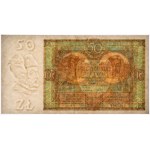Definitely a rarer variety with a dot separating the letters of the series.
File deflection through the center with a natural hump.
Two small rust holes from the stapler in the upper margin.
Minor corns in the unprinted area.
The banknote is stunning in its printing freshness with beautiful embossed printing.
Rare in this state of preservation.
Banknotes released into circulation after March 1, 1927 were not created from a single order. Their appearance was the result of orders from the Bank of Poland to the Polish Security Printing Works and the outcome of competitions for banknote designs. The banknotes issued by the Bank of Poland at the time were the work of five Polish artists of the time: Waclaw Borowski, Zdzislaw Eichler, Zygmunt Kaminski, Ryszard Kleczewski and Jozef Mehoffer.
A characteristic feature of the paper money introduced after 1927 is that part of the banknote's surface was left for a watermark depicting a bust of a national hero. The range of symbolic representations, which refer to the history of the Polish state and its contemporaneity, was greatly expanded on these banknotes. The graphic design of Polish banknotes also included references to the Poland that was being built in the interwar period.
The turn of the 1920s and 1930s was the time when the second issues of banknotes designed as part of the competition struggles were put into circulation. In the second half of the 1930s, the authorities of the Bank of Poland commissioned Waclaw Borowski to develop a graphically consistent series of paper money. Only 20 gold issues from 1936 were put into circulation. Work on the series was interrupted by the outbreak of World War II.










